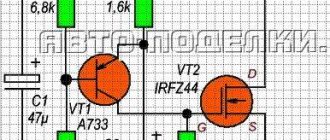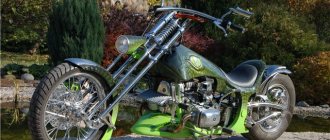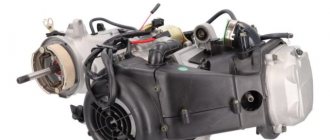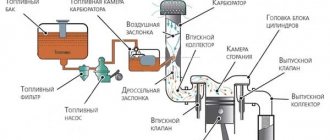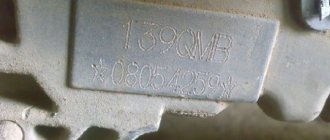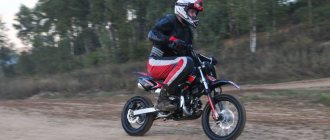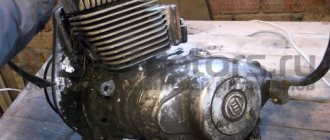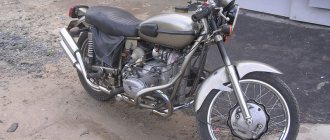How to convert an air-cooled engine to a water-cooled one
Message by uvat » 12 Dec 2009, 15:41
In various topics I answered questions about converting the Planet engine to water cooling, so I decided to put everything together. Minimum kit for conversion: PD-10 cylinder, PD-10 cylinder head, studs with nuts from PD-10, head gasket, exhaust manifold gasket, gaskets for pipes on the cylinder and head, bleed valve on the PD-10 head (you can just use a bolt as a plug). The adapter for the carburetor is homemade. The exhaust manifold is homemade. Temperature sensor and device, there are two options: from VAZ-06 and UAZ, the sensor fits into the cylinder head or into the upper pipe, the latter option is more convenient.
We remove all casting roughness in the cylinder bores using a semicircular and round file; you can remove the tongue from the intake window (using a jigsaw). The piston, piston pin and rings are all planetary, we select the piston according to the PD-10 cylinder.
We use an electric pump from Gazelle.
The exhaust manifold is completely homemade, in my version the flange is made of 6mm metal, the body itself is made of a square profile 50502, a pipe is welded into it at the required angle (depending on the layout), but you can use the factory PD-10 muffler by reshaping it.
I used a radiator from a VAZ 10ki, but there may be other options (ideally a copper radiator from a VAZ-2121 or Gazelle). Forced airflow is carried out using a standard electric fan or by making a homemade casing and installing a motor with an impeller from a car interior heater (VAZ, UAZ). The choice of motor and radiator largely depends on operating conditions and ambient temperature. For example: when driving through a heavy swamp with a load on pneumatic tires at 1300, it is better to install a standard electric radiator blower, but when operating a caracat on a Bel-79 and in less severe conditions, a motor from the interior heater stove will be enough. To turn on the electric fan, we use a standard sensor located in the radiator.
The electric pump is driven by a sensor installed in the upper radiator pipe; in case of an emergency, you can install a toggle switch to force the pump to turn on and make a control light on the instrument panel indicating that the pump is turned on. The pump is connected to the water circuit parallel to the lower radiator pipe in order to take full advantage of the capabilities of the thermosyphon cooling system. Pump characteristics: Design designation 32.3780 Rated voltage 12 V Maximum current 4.0 A Created pressure 0.15 kg/cm2 Weight 1.15 kg The pump and electric fan activation sensors are switched on via a relay and protected by fuses. We select the temperature of the sensors individually, depending on the operating conditions. The use of a water cooling system on a caracat significantly increases engine life. There is not a significant loss of power (theoretically), but in practice it is not noticeable due to the large reduction in the transmission. This article was written more in relation to karakats; modifications on a motorcycle will have some nuances.
Source
Do-it-yourself water cooling for Izh Planet Five
Post by uvat » 12 Dec 2009, 15:41
In various topics I answered questions about converting the Planet engine to water cooling, so I decided to put everything together. Minimum kit for conversion: PD-10 cylinder, PD-10 cylinder head, studs with nuts from PD-10, head gasket, exhaust manifold gasket, gaskets for pipes on the cylinder and head, bleed valve on the PD-10 head (you can just use a bolt as a plug). The adapter for the carburetor is homemade. The exhaust manifold is homemade. Temperature sensor and device, there are two options: from VAZ-06 and UAZ, the sensor fits into the cylinder head or into the upper pipe, the latter option is more convenient.
We remove all casting roughness in the cylinder bores using a semicircular and round file; you can remove the tongue from the intake window (using a jigsaw). The piston, piston pin and rings are all planetary, we select the piston according to the PD-10 cylinder.
We use an electric pump from Gazelle.
The exhaust manifold is completely homemade, in my version the flange is made of 6mm metal, the body itself is made of a square profile 50502, a pipe is welded into it at the required angle (depending on the layout), but you can use the factory PD-10 muffler by reshaping it.
I used a radiator from a VAZ 10ki, but there may be other options (ideally a copper radiator from a VAZ-2121 or Gazelle). Forced airflow is carried out using a standard electric fan or by making a homemade casing and installing a motor with an impeller from a car interior heater (VAZ, UAZ). The choice of motor and radiator largely depends on operating conditions and ambient temperature. For example: when driving through a heavy swamp with a load on pneumatic tires at 1300, it is better to install a standard electric radiator blower, but when operating a caracat on a Bel-79 and in less severe conditions, a motor from the interior heater stove will be enough. To turn on the electric fan, we use a standard sensor located in the radiator.
The electric pump is driven by a sensor installed in the upper radiator pipe; in case of an emergency, you can install a toggle switch to force the pump to turn on and make a control light on the instrument panel indicating that the pump is turned on. The pump is connected to the water circuit parallel to the lower radiator pipe in order to take full advantage of the capabilities of the thermosyphon cooling system. Pump characteristics: Design designation 32.3780 Rated voltage 12 V Maximum current 4.0 A Created pressure 0.15 kg/cm2 Weight 1.15 kg The pump and electric fan activation sensors are switched on via a relay and protected by fuses. We select the temperature of the sensors individually, depending on the operating conditions. The use of a water cooling system on a caracat significantly increases engine life. There is not a significant loss of power (theoretically), but in practice it is not noticeable due to the large reduction in the transmission. This article was written more in relation to karakats; modifications on a motorcycle will have some nuances.
Source
Homemade water cooling on IZH Planet-5
Homemade water cooling for IZH Planet-5, made from a cylinder with a head from the PD-10 starting engine of the MTZ-80 tractor.
Greetings to all motorcycle enthusiasts! In this article, we will talk about a simple and effective method for making water cooling for an IZH motorcycle. Izh Planeta-5 at one time was considered a good motorcycle of the Soviet and post-Soviet period. The device was unpretentious, reliable and easy to use.
But the technique was far from ideal. It is not difficult to overheat an air-cooled engine. In this article I will write how to solve the overheating problem by installing a water cooling system on IZ Planet 5.
I would like to point out that this method is not a 21st century innovation. This was done back in Soviet times. This is a proven and working scheme. To install the cylinder from the PD-10 “launcher” onto the IZh crankcase, you need to make an adapter plate. The piston remains from the Planet, but the connecting rod is thicker than originally in the PD-10 cylinder. To ensure that the connecting rod does not touch the cylinder walls, it is necessary to expand the lower part of the liner. The wall thickness of the sleeve is sufficient to carry out such work.
The coolant is supplied by an electric pump from the gazelle to the lower part of the cylinder. Then the antifreeze leaves the top of the cylinder and enters the cylinder head, from the cylinder head it further moves to the cooling radiator, and from the radiator back to the pump.
A three-row copper radiator for the VAZ-2106 heater stove was used as a cooling radiator.
Its performance is more than enough for this small engine. True, the system works without a thermostat, I don’t know how correct this is. On the steering wheel there is a small expansion tank made from a paint can.
“Extra” liquid is supplied to the tank through a fitting. The lid has a spring valve that releases excess pressure along the threads of the lid. The expansion tank looks primitive, but it does its job.
After installing the MT-10 cylinder, the engine began to sound like a tractor. We had to redo the exhaust tract and install a second muffler, as was the case on previous “planets”.
In general, after all this tuning, the problem with engine overheating was solved. The motor can be turned up to 8500 rpm without fear of overheating.
The Soviet motorcycle has gained the opportunity to exist in our days, moving dynamically on public roads.
Video review of Izh Jupiter-5 with water cooling:
Source
Homemade cars
Homemade water cooling for IZH Planet-5, made from a cylinder with a head from the PD-10 starting engine of the MTZ-80 tractor.
Greetings to all motorcycle enthusiasts! In this article, we will talk about a simple and effective method for making water cooling for an IZH motorcycle. Izh Planeta-5 at one time was considered a good motorcycle of the Soviet and post-Soviet period. The device was unpretentious, reliable and easy to use.
But the technique was far from ideal. It is not difficult to overheat an air-cooled engine. In this article I will write how to solve the overheating problem by installing a water cooling system on IZ Planet 5.
I would like to point out that this method is not a 21st century innovation. This was done back in Soviet times. This is a proven and working scheme. To install the cylinder from the PD-10 “launcher” onto the IZh crankcase, you need to make an adapter plate. The piston remains from the Planet, but the connecting rod is thicker than originally in the PD-10 cylinder. To ensure that the connecting rod does not touch the cylinder walls, it is necessary to expand the lower part of the liner. The wall thickness of the sleeve is sufficient to carry out such work. The coolant is supplied by an electric pump from the gazelle to the lower part of the cylinder. Then the antifreeze leaves the top of the cylinder and enters the cylinder head, from the cylinder head it further moves to the cooling radiator, and from the radiator back to the pump.
A three-row copper radiator for the VAZ-2106 heater stove was used as a cooling radiator.
Its performance is more than enough for this small engine. True, the system works without a thermostat, I don’t know how correct this is. On the steering wheel there is a small expansion tank made from a paint can.
“Extra” liquid is supplied to the tank through a fitting. The lid has a spring valve that releases excess pressure along the threads of the lid. The expansion tank looks primitive, but it does its job.
After installing the MT-10 cylinder, the engine began to sound like a tractor. We had to redo the exhaust tract and install a second muffler, as was the case on previous “planets”.
In general, after all this tuning, the problem with engine overheating was solved. The motor can be turned up to 8500 rpm without fear of overheating.
The Soviet motorcycle has gained the opportunity to exist in our days, moving dynamically on public roads.
Video review of Izh Jupiter-5 with water cooling:
Homemade author: Matvey Sinekov.
Share on social media networks
Popular homemade products on our website
- Homemade tricycle from Izh Planet 5
- Restoration of the IZH Planeta-5 motorcycle (33 photos)
- Restoring the Izh Planet 5 motorcycle
- DIY Karakat from the Izh Planet 3 motorcycle
How to convert an air-cooled engine to a water-cooled one
Post by uvat » 12 Dec 2009, 15:41
In various topics I answered questions about converting the Planet engine to water cooling, so I decided to put everything together. Minimum kit for conversion: PD-10 cylinder, PD-10 cylinder head, studs with nuts from PD-10, head gasket, exhaust manifold gasket, gaskets for pipes on the cylinder and head, bleed valve on the PD-10 head (you can just use a bolt as a plug). The adapter for the carburetor is homemade. The exhaust manifold is homemade. Temperature sensor and device, there are two options: from VAZ-06 and UAZ, the sensor fits into the cylinder head or into the upper pipe, the latter option is more convenient.
We remove all casting roughness in the cylinder bores using a semicircular and round file; you can remove the tongue from the intake window (using a jigsaw). The piston, piston pin and rings are all planetary, we select the piston according to the PD-10 cylinder.
Homemade water cooling on IZH Planet-5
Homemade water cooling for IZH Planet-5, made from a cylinder with a head from the PD-10 starting engine of the MTZ-80 tractor.
But the technique was far from ideal. It is not difficult to overheat an air-cooled engine. In this article I will write how to solve the overheating problem by installing a water cooling system on IZ Planet 5.
I would like to point out that this method is not a 21st century innovation. This was done back in Soviet times. This is a proven and working scheme. To install the cylinder from the PD-10 “launcher” onto the IZh crankcase, you need to make an adapter plate. The piston remains from the Planet, but the connecting rod is thicker than originally in the PD-10 cylinder. To ensure that the connecting rod does not touch the cylinder walls, it is necessary to expand the lower part of the liner. The wall thickness of the sleeve is sufficient to carry out such work. The coolant is supplied by an electric pump from the gazelle to the lower part of the cylinder. Then the antifreeze leaves the top of the cylinder and enters the cylinder head, from the cylinder head it further moves to the cooling radiator, and from the radiator back to the pump.
A three-row copper radiator for the VAZ-2106 heater stove was used as a cooling radiator.
Its performance is more than enough for this small engine. True, the system works without a thermostat, I don’t know how correct this is. On the steering wheel there is a small expansion tank made from a paint can.
“Extra” liquid is supplied to the tank through a fitting. The lid has a spring valve that releases excess pressure along the threads of the lid. The expansion tank looks primitive, but it does its job.
After installing the MT-10 cylinder, the engine began to sound like a tractor. We had to redo the exhaust tract and install a second muffler, as was the case on previous “planets”.
In general, after all this tuning, the problem with engine overheating was solved. The motor can be turned up to 8500 rpm without fear of overheating.
The Soviet motorcycle has gained the opportunity to exist in our days, moving dynamically on public roads.
Video review of Izh Jupiter-5 with water cooling:
Mcl007 › Blog › Installing liquid cooling on IZ Jupiter 5
Hi all!
There are more and more cases when people ask me “oh! how did you make water cooling for Jupiter?” Therefore, it was decided to write this note in which we briefly describe the process of installing liquid cooling on the IZH Jupiter 5K motorcycle. According to the documents, I have a motorcycle IZH 6.114, model Jupiter 5K, produced in 1988. The prefix “K” means that the motorcycle comes with a VMZ side trailer, in common parlance a cradle or stroller.
The motorcycle has been in my hands since 2007 and has undergone many changes during this time. About one of them below.
Chapter 1. How it all began
Waking up one fine morning, I realized that my hands were itching not because they were dirty, but because of a wild desire to create some kind of miracle with my horse, and I went to the great and mighty Internet to read the information and absorb it like a spongebob. Having read the theory, we move on to practice and hammer the screw on this matter because it is very difficult and there is a lot of money. But my hands don’t give me rest. A friend and I once went to Birobidzhan and a great tragedy happened to us, the engine overheated and jammed (((We are standing on the highway, 10-15 kilometers to the city, 70 kilometers to the house, the engine is jammed, sadness in the eyes. Having rested, cooled down , having drunk the juice, we begin the repair. We took off the heads. The pistons were stripped, and so was the cylinder mirror. There is nothing to do, we put it back together. Just for fun, we try to start it. Hmm, the crankshaft began to turn, and even grabbed, and even started! However, I wanted to drive a maximum of 60 km/h = ((but this was enough to get to the city (yes, we didn’t return home straight away, but drove on). Upon returning home, the first thing I did was scatter the engine around the garage and realized that the moment had come and it was time to start installing water cooling. It was September, ahead long winter evenings, this is the moment of truth!
So, all we need to know:
engines were of the following series:
crankcases IZH Yu5 sb.1 - sb.1-05 air cooling (my version) crankcases IZH Yu5 sb.1-07 air cooling, but allow the installation of liquid cooling crankcases IZH Yu5 sb.1-08 liquid cooling
The brand of the crankcase can be found on the front mount of the engine to the frame, not far from its serial number.
Installing “water” cylinders in crankcases 07 and 08 is not a tricky matter; in fact, they are the same crankcase, which has a deeper crank chamber. But in 05 the crankcase is a whole story. The thing is that structurally the cylinder-piston group in the 07-08 engine is shifted lower, the cylinder skirts, the piston skirt, and the crankcase are shifted deeper. In this case, the piston stroke and connecting rod dimensions remain the same. For what? ask the designers))
As usual, there are several ways out:
1. Mill the KShK and install the “water” CPG kit 2. Make a 7 mm spacer from aluminum and thereby raise the “water” cylinder above the crankcase and leave the “air” piston. In this case, it is necessary to make extended studs for fastening head 3. Cut off the excess and install the “water” CPG in the “air” CSG
The first option was not considered in principle, a manual router? where can I get it... What if I screw up the KShK? looking for a new crankcase... definitely not suitable. Make a spacer? Well, according to the shape of the gasket, it would be possible to make a spacer and it’s all in the bag, but adjusting the compression ratio depending on the thickness of this gasket did not inspire me, especially since there are two cylinders. It's decided - let's cut it!
Air-cooled gas generator in the engine compartment
#51 motoras
Sorry, I don’t understand. Did you make an exhaust pipe with a water “jacket” or is it a “wet” exhaust?
Asbestos “burns” at first, this is normal, the binder burns out. But to prevent it from crumbling over time, wrap it in fiberglass, top it with sauna tape and that’s it.
Does anyone have experience installing an electric starter on similar units? From a scooter, or something else.
#52 stronov
Post edited by stronov: August 22, 2010 - 19:35
#53 Svo
#54 motoras
An alternative to asbestos is basalt-based thermal insulation. The top is insulated in the same way. Asbestos to ash - something that just doesn’t happen in the world.
I spent my entire life sealing the stoves with asbestos. And here it is. I was shocked myself.
But the collector needs to be cooled, even because the temperature difference will quickly kill any metal (unless, of course, the collector is made of ceramics).
#55 motoras
I have been using this design on an 8-meter yacht for 11 years now. But this year I will redo everything. My exhaust was made of titanium corrugation from rocket technology. It rotted and began to filter the water. I will replace it with a stainless steel pipe on water-cooled pipes. The plastic case is protected normally. The exhaust is under water. The fitting is a pipe in a stainless steel pipe. The upper edge is higher than the CVL. And the most important thing. I want to convert air cooling to water cooling. I'll make a shirt. The instructions for the engine say: do not start when the ambient air is more than 30 degrees C. And this summer it was 30 degrees even at night. And the engine actually stalled. I'm thinking of using a thermostat from a 25 horsepower Honda. By the way, I also covered the asbestos with fiberglass, and then with aluminum adhesive foil, but still, six months later I discovered a layer of asbestos dust in the compartment. And asbestos is a carcinogen. So you need to remove it from the boat immediately.
#56 Belomor
#57 Aleksk
If it’s a joke, then I laughed, but if it’s an exam, I invite you to check everything yourself.
#58 Svo
I spent my entire life sealing the stoves with asbestos. And here it is. I was shocked myself.
But the collector needs to be cooled, even because the temperature difference will quickly kill any metal (unless, of course, the collector is made of ceramics).
#59 stronov
Or maybe after 11 years it’s time to replace the generator? Completely different engines appeared. Mine has no temperature restrictions, it is written that it should be used outdoors (which I violated) and that’s all.
#60 Aleksk
The instructions indicate a motor life of 17,000 hours,
By the way, for a car this is a mileage of 1 million kilometers.
#61 motoras
The instructions indicate a service life of 17,000 hours, but it worked for me for 500 hours. The generator has actually already been changed. I didn’t disconnect it from the network and turned it on to the shore.
#62 grandfather
My generator has a service life of 500 hours. I think it's a good time. I made a shore-neutral-generator switch.
#63 stronov
#64 motoras
#65MM
Here I was feeling my generator after an hour of work. I stuck my finger into the hole between the soundproofing housing and the exhaust manifold, there are just the cooling fins of the cylinder head in the exhaust area - my finger didn’t get burned. It feels like about 70-80 degrees.
#66 Breget
#67 Svo
Post edited by Svo: September 01, 2010 - 18:13
How to water cool an air cooled engine
Post by uvat » 12 Dec 2009, 15:41
In various topics I answered questions about converting the Planet engine to water cooling, so I decided to put everything together. Minimum kit for conversion: PD-10 cylinder, PD-10 cylinder head, studs with nuts from PD-10, head gasket, exhaust manifold gasket, gaskets for pipes on the cylinder and head, bleed valve on the PD-10 head (you can just use a bolt as a plug). The adapter for the carburetor is homemade. The exhaust manifold is homemade. Temperature sensor and device, there are two options: from VAZ-06 and UAZ, the sensor fits into the cylinder head or into the upper pipe, the latter option is more convenient.
We remove all casting roughness in the cylinder bores using a semicircular and round file; you can remove the tongue from the intake window (using a jigsaw). The piston, piston pin and rings are all planetary, we select the piston according to the PD-10 cylinder.
We use an electric pump from Gazelle.
The exhaust manifold is completely homemade, in my version the flange is made of 6mm metal, the body itself is made of a square profile 50502, a pipe is welded into it at the required angle (depending on the layout), but you can use the factory PD-10 muffler by reshaping it.
I used a radiator from a VAZ 10ki, but there may be other options (ideally a copper radiator from a VAZ-2121 or Gazelle). Forced airflow is carried out using a standard electric fan or by making a homemade casing and installing a motor with an impeller from a car interior heater (VAZ, UAZ). The choice of motor and radiator largely depends on operating conditions and ambient temperature. For example: when driving through a heavy swamp with a load on pneumatic tires at 1300, it is better to install a standard electric radiator blower, but when operating a caracat on a Bel-79 and in less severe conditions, a motor from the interior heater stove will be enough. To turn on the electric fan, we use a standard sensor located in the radiator.
The electric pump is driven by a sensor installed in the upper radiator pipe; in case of an emergency, you can install a toggle switch to force the pump to turn on and make a control light on the instrument panel indicating that the pump is turned on. The pump is connected to the water circuit parallel to the lower radiator pipe in order to take full advantage of the capabilities of the thermosyphon cooling system. Pump characteristics: Design designation 32.3780 Rated voltage 12 V Maximum current 4.0 A Created pressure 0.15 kg/cm2 Weight 1.15 kg The pump and electric fan activation sensors are switched on via a relay and protected by fuses. We select the temperature of the sensors individually, depending on the operating conditions. The use of a water cooling system on a caracat significantly increases engine life. There is not a significant loss of power (theoretically), but in practice it is not noticeable due to the large reduction in the transmission. This article was written more in relation to karakats; modifications on a motorcycle will have some nuances.
Background.
It all started with the idea of changing a video card, something like 1070 from a gigabyte, the long one for 3 coolers)) Because. it’s long, my old case was already trimmed in order to fit the R9 270x from a gigabyte, so it was decided to replace the case with a more modern one (the old case is already 8 years old).
I thought - “why not replace the cooler on the processor?” My previous cooler, Scythe Katana 3 , seemed meager and dull compared to the new case!
I looked at what was available, read reviews and tests, the choice was between towers with 2 fans DEEPCOOL Neptwin V2 or Scythe Fuma Rev.B , dropsy DEEPCOOL GAMMAXX L120T or Deepcool GAMMAXX L240
Tests show that for your money this is a working option! But the opinion of some users was this: the stock fan is weak and has a flaw in the form of slits through which air escapes and does not go 100% to the radiator honeycombs!
I immediately replaced the stock one with two DEEPCOOL UF120 , installing them on both sides!
Welcome to VAZ.EE+ Extended Edition
Since May 2013, our portal has expanded the thematic sections of the forum for the exchange of experience: subforums Americans, Koreans, Germans, French, Japanese have been added, due to the increase in the fleets of our visitors.
In addition to changing the style, our Chat, Mail, Entertainment and photo/video sections, Literature have become built-in and do not require separate registration. In addition, there are other useful and pleasant innovations that you can all familiarize yourself with when visiting the portal.
You can contact the administration with questions and suggestions in a special section of the forum or through the feedback form.
Tests and general impressions of the life support system
CPU temperature
idle (after warming up) - 50-52
in the stress test - 55-60 (seemingly quite acceptable)
in WOT at maximum - 62s (fans at 100%, take off)
Food temperature (as it turns out, this is where legs grow)
in the stress test - 65 (quite acceptable)
in WOT at maximum - 69 (fans at 100%, take off)
From the photo above you can see how the power radiator is closed on all sides and practically nothing blows through it! This was the first sign of the problem of cooling the system unit in general!
Next, I decided to read tests and reviews of fans for LSS; as it turned out, not all fans are suitable for hundreds of LSS radiators. After receiving new information, a fan for dropsy was purchased
The result is the same as with 2 DEEPCOOL UF120. The temperature at the processor's power supply dropped by a couple of degrees. The sound from the system unit has not changed, the fans are working at their limit!
Hence the conclusion - having originally purchased Scythe Katana 3 many years ago, I made an incredibly smart choice! )) But this is not only for this reason, I’ll tell you later!
Now I realized my mistake - LSS is not suitable for all motherboards and cases!
Next, I set out to look for a cooler that is somehow directed towards the heatsink of the processor's power supply; without thinking twice I chose Scythe Choten
Experimental motorcycle IZH Planet-6 with liquid cooling, which you didn’t know about
We're talking about the little-known IZH motorcycle, which never went into production
I am sure that many of you have heard about IZ Planet-3, Planet-4 and, of course, Planet-5. It is believed that it was the fifth Planet that became the last model in the series, but this is not entirely true. There was also IZH Planet-6, which was not mass produced, and therefore few people know about it.
In fact, the new engine was a modernization of the previous IZH-P5-01. But it received a liquid cooling system, non-contact ignition, separate lubrication system and a five-speed gearbox. Here is a diagram of this engine in one of the repair books:
For some reason, the Russian press ignored the appearance of a new motorcycle model. Apparently, no one believed in the possibility of organizing mass production in difficult economic and political times. MOTO magazine made only a small note about it:
The sample, photographs of which were published by the magazine, was later purchased by one of the Russian motorcycle collectors and restored to its authentic condition. This is what the bike looked like before the restoration began:
And he became such a handsome man after all the work:
Aleksei43RUS told the story of the restoration of one such motorcycle in his blog. He managed to buy a completely new P-6 engine quite by accident (yes, I just found an ad on Avito). Having received it by a transport company, Alexey carried out all the necessary work to resuscitate it and installed it on his motorcycle.
This is how he describes his feelings from the first test ride:
It's time for the first departure. It wasn't particularly warm, it was a little dirty. Well, I really wanted to try the engine. Having adjusted the clutch, I went to the bypass. You can feel the piston from IZH-PS, it pulls like crazy. Well, compared to the usual engine from Planet, this one seemed more cheerful to me.
Tests and impressions of SVO
CPU temperature
idle (after warming up) - 46-48 (silence)
in the stress test - 55-57 (excellent and not noisy)
in WOT at maximum - 60-61s (normal, fans at 70%, still comfortable)
Supply temperature
in the stress test - 60-62
in WOT at maximum - 63-65
It cools both the processor and the power radiator perfectly! Does not interfere with “high” operation. You can turn it over and cool the RAM!
As you may have noticed, the temperature has not dropped by much, but there is a huge plus - this is noise, i.e. Now, to maintain the temperature even lower than before, you need less fan speed! Because The fan speed settings remain the same; if you turn them up to maximum speed, I think the temperature will drop even more, but the noise will go beyond the comfortable limit!
conclusions
Cheap water cooling for a home computer is ineffective, especially with a single-section radiator. Its advantages are the removal of heat from the processor, with the direct blowing of hot air from the system unit, but this is if we talk about a 3-section radiator! Perhaps such a cheap dropsy will be suitable for unloaded systems, instead of a boxed cooler, with an installation tailored for modding.
A separate conclusion about the case - before this there was a narrow case, which made it possible for 2m 120mm fans to blow well over the motherboard components due to the narrow air flow! In a large, spacious case, the air flow is dissipated, thereby blowing worse at the motherboard elements. Perhaps such cases require special fans for purging the case, the price tag of which is 1.5k+, but this is not certain)) and I will never know about it))
Perhaps my article will help someone in choosing cooling) Good luck to everyone!
Air or dropsy?! Which engine is better?!
Greetings! My name is Alexey and I am the CEO of PITBIKECLUB.
